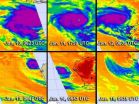(Press-News.org) Researchers at Western University in London, Canada, have identified a new genetic mutation for amyotrophic lateral sclerosis (ALS), opening the door to future targeted therapies. Dr. Michael Strong, a scientist with Western's Robarts Research Institute and Distinguished University Professor in Clinical Neurological Sciences at the Schulich School of Medicine & Dentistry, and colleagues found that mutations within the ARHGEF28 gene are present in ALS. When they looked across both familial and sporadic forms of the disease, they found that virtually all cases of ALS demonstrated abnormal inclusions of the protein that arises from this gene. The research is published online in Amyotrophic Lateral Sclerosis and Frontotemporal Degeneratio, the official journal of The World Federation of Neurology Research Group on Motor Neuron Diseases.
VIDEO:
Researchers at Western University in London, Canada, have identified a new genetic mutation for amyotrophic lateral sclerosis (ALS), opening the door to future targeted therapies. Dr. Michael Strong and...
Click here for more information.
ALS, sometimes called Lou Gehrig's disease, is a progressive disease that affects the motor neurons that connect the brain to muscles throughout the body. It is a devastating disease with 90 per cent of patients dying within five years of diagnosis. As many as 30,000 Americans and 2,000 Canadians are living with ALS.
Strong's team is convinced ALS is a disorder of RNA metabolism. RNA is the intermediary or messenger between genes and the protein being made. This new protein appears to play a critical role. "Every time we look at a cell degenerating, this particular protein was deposited abnormally in the cell. It was a common denominator," explains Strong, who is also the Dean of Schulich Medicine & Dentistry. "Working with Dr. Rob Hegele at Robarts, we found there was a genetic mutation in the gene coding for this protein. So it's a huge discovery."
VIDEO:
Using confocal microscopy, Dr. Michael Strong of Western University's Schulich School of Medicine & Dentistry shows how abnormal protein from the ARHGEF28 gene is deposited in a motor neuron from...
Click here for more information.
Unlike most proteins which have one key function, this one has two. "One side works with RNA. The other side has the capacity to regenerate or to deal with an injury. We think those are competitive activities so if it's doing one, it's not available to do the other," says Strong. In the case of ALS, Strong believes the protein is disturbed on the RNA side so it's no longer able to respond to cell injury. "We need to understand what causes the switch between the two functions, and then can we modulate it."
INFORMATION:
The research was funded by the Canadian Institutes of Health Research and the ALS Society of Canada.
Western University researchers identify new genetic mutation for ALS
2013-01-16
ELSE PRESS RELEASES FROM THIS DATE:
For sports fans, the story -- not the victor -- makes the difference in enjoyment
2013-01-16
CORVALLIS, Ore. – A new study has concluded that sports fans love to root for a hero and against a villain, but if the game is exciting, they'll enjoy it no matter who wins.
The research, recently published in the Journal of Media Psychology, examines emotional experiences, outcome satisfaction, and enjoyment of athletic events, particularly ones featuring individual athletes rather than team sports.
Lead author Colleen Bee, an assistant professor of marketing at Oregon State University, said the Olympics are a good example of an event where fans often cheer for little-known ...
Researchers identify ways to improve quality of care measurement from electronic health records
2013-01-16
NEW YORK (January 15, 2013) -- Health care providers and hospitals are being offered up to $27 billion in federal financial incentives to use electronic health records (EHRs) in ways that demonstrably improve the quality of care. The incentives are based, in part, on the ability to electronically report clinical quality measures. By 2014, providers nationwide will be expected to document and report care electronically, and by 2015, they will face financial penalties if they don't meaningfully use EHRs.
A new, federally-funded study by Weill Cornell Medical College in ...
International study: Where there's smoke or smog, there's climate change
2013-01-16
In addition to causing smoggy skies and chronic coughs, soot – or black carbon – turns out to be the number two contributor to global warming. It's second only to carbon dioxide, according to a four-year assessment by an international panel.
The new study concludes that black carbon, the soot particles in smoke and smog, contributes about twice as much to global warming as previously estimated, even by the 2007 Intergovernmental Panel on Climate Change.
"We were surprised at its potential contribution to climate," said Sarah Doherty, a University of Washington atmospheric ...
New American Chemical Society podcast: Leaves of carob tree fight food-poisoning bacteria
2013-01-16
The latest episode in the American Chemical Society's (ACS') award-winning Global Challenges/Chemistry Solutions podcast series reports that an antibacterial extract from the leaves of the carob tree (the source of a popular chocolate substitute) could fight the microbe responsible for the serious form of food poisoning called listeriosis.
Based on a report by Pierluigi Caboni, Ph.D., Nadhem Aissani and colleagues in ACS' Journal of Agricultural and Food Chemistry, the new podcast is available without charge at iTunes and from www.acs.org/globalchallenges.
In the ...
Novel approach to track migration of arctic-breeding avian species
2013-01-16
Animals move around the globe in billions, sometimes - like the snow bunting - one of the iconic Arctic-breeding species, covering huge distances and enduring the most extreme frigid weather conditions. In this conspicuously white sparrow-sized bird, animal migration epitomizes a stunning success of biological adaptation – with Snow Bunting representing the only songbird to breed as far north as the Arctic Circle. Indeed, there is nothing north of the snow bunting's breeding ground except the North Pole and the polar ice cap. These passerines thrive in chilly, alpine conditions, ...
Studies provide new insights into brain-behavior relationships
2013-01-16
Amsterdam, NL, January 15, 2013 – Approximately half a million individuals suffer strokes in the US each year, and about one in five develops some form of post-stroke aphasia, the partial or total loss of the ability to communicate. By comparing different types of aphasia, investigators have been able to gain new insights into the normal cognitive processes underlying language, as well as the potential response to interventions. Their findings are published alongside papers on hemispatial neglect and related disorders in the January, 2013 issue of.
The January issue of ...
NASA finds 2012 sustained long-term climate warming trend
2013-01-16
NASA scientists say 2012 was the ninth warmest of any year since 1880, continuing a long-term trend of rising global temperatures. With the exception of 1998, the nine warmest years in the 132-year record all have occurred since 2000, with 2010 and 2005 ranking as the hottest years on record.
NASA's Goddard Institute for Space Studies (GISS) in New York, which monitors global surface temperatures on an ongoing basis, released an updated analysis Tuesday that compares temperatures around the globe in 2012 to the average global temperature from the mid-20th century. The ...
Choline supplementation during pregnancy presents a new approach to schizophrenia prevention
2013-01-16
AURORA, Colo. (Jan. 15, 2013) — Choline, an essential nutrient similar to the B vitamin and found in foods such as liver, muscle meats, fish, nuts and eggs, when given as a dietary supplement in the last two trimesters of pregnancy and in early infancy, is showing a lower rate of physiological schizophrenic risk factors in infants 33 days old. The study breaks new ground both in its potentially therapeutic findings and in its strategy to target markers of schizophrenia long before the illness itself actually appears. Choline is also being studied for potential benefits ...
Infrared NASA imagery shows sinking air, elongation in Tropical Storm Emang
2013-01-16
The Atmospheric Infrared Sounder instrument that flies on NASA's Aqua satellite provides valuable data to tropical cyclone forecasters, and revealed sinking air, a small area of powerful thunderstorms, and a slightly elongated Tropical Storm Emang.
Infrared data on Tropical Storm Emang's cloud top temperatures was captured by the Atmospheric Infrared Sounder (AIRS) instrument on Jan. 15 at 0823 UTC (3:23 a.m. EST). AIRS data showed that the largest area of powerful thunderstorms were in the northern half of the storm. That area showed cold cloud top temperatures of -63F ...
NASA satellites see Cyclone Narelle torn apart
2013-01-16
NASA's TRMM and Aqua satellites showed how Tropical Cyclone Narelle has fallen far from being a powerful cyclone in the Southern Indian Ocean. A time series of infrared images from an Aqua satellite instrument provides a clear picture of Narelle's former power and its recent demise, while TRMM 3-D data showed falling cloud heights and weaker rainfall.
Narelle, once a powerful tropical cyclone with winds of 115 knots (~132 mph), was equivalent to a category 4 hurricane on the Saffir-Simpson scale. The storm has continued to steadily weaken as it made its way southward ...




